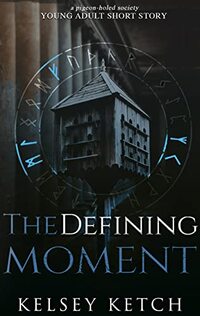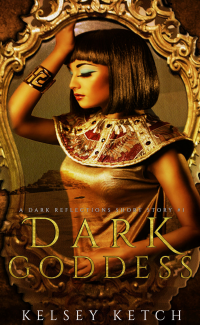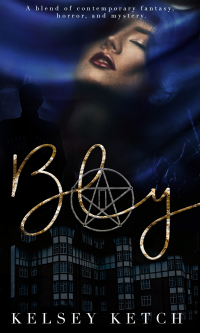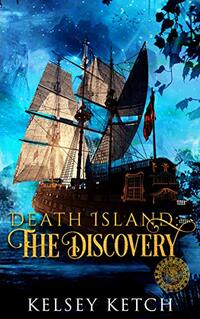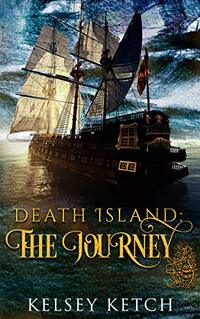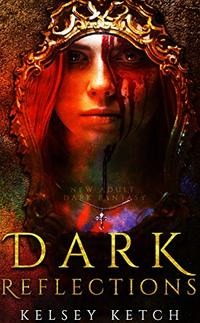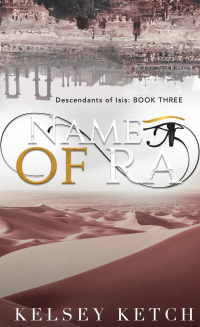Kelsey Ketch Interview Published on: 14, Jan 2019
 Where did you grow up? Have you ever written about your hometown or your own childhood experiences in any of your books?
Where did you grow up? Have you ever written about your hometown or your own childhood experiences in any of your books?
I grew up in both Northern California in the Bay Area and in the suburbs of Denver, Colorado. I have yet to set a novel in any particular location I grew up; however, San Francisco had a cameo appearance in “Son of Set.” And I weave plenty of my life experiences into my novels, from childhood traumas, such as my father’s death and my reason for fearing horses, to current events.
Since you are a biologist in addition to being an author, how do you manage time between writing and working as a Wildlife Biologist in the state of North Carolina?I manage time between writing and work by mainly writing when I have an opportune moment. As a wildlife biologist, my schedule can become very random, depending on the season. During a normal day, I can write during my hour lunch break and in the evenings. Days where my schedule is extended because of field work or travel, I attempt to either write in the early morning or late evenings. Though, there are just days where I can’t get any writing in at all, in which case, I wait for the weekends or take a day off using my overtime hours.
When did you decide to finally sit down, write a complete book and get it published? Tell us a little about your debut book and how it has helped change your life for the better? Is there anything you wish you could've done differently?I decided to sit down and write my first novel during my junior year, but I didn’t decide to pursue publishing until my senior year of college. However, the novel I was attempting to publish at the time, “Death Island,” hit a dead end in traditional publishing. So, it was “Daughter of Isis” that actually became my debut novel.
After waiting for a response from a small publisher for nine months, “Daughter of Isis” was my first novel to pursue publishing on my own (a.k.a. self-publishing). It was so liberating. Until that point, I had only attempted traditional avenues, but by taking a chance, I found a publishing method that suited my lifestyle. There are no months of waiting for a response from anyone. No strict guidelines or deadlines to follow. I can produce a novel on my time. The only thing I would have done different with “Daughter of Isis” is have it edited a second time and done a read out loud before publishing the first edition.
What gave you the idea for your book "Death Island?" What would you do if, one day, a gang of pirates attacks your city?It was a mix of watching the first “Pirates of the Caribbean,” my crush in high school, and the death of my father and grandparents that sparked “Death Island.” It was a way to cope with my emotions, and since my happiest memories were of the “Pirates of the Caribbean” ride in Disneyland, I wanted to set the novel during the Golden Age of Piracy. Piecing together scene by scene until “Death Island” became a 1,000-page novel, which I later had to cut down. If pirates were to attack my city, I hope I would be as reactive as my main character, Meriden, and kick some pirate bum. Especially since my first and foremost duty would be to protect my home and family.
When starting a series, do you decide beforehand how many books and characters you want to write about? Or do you just begin and see where it takes you? What was the most difficult part to describe in the "Descendants of Isis" series?I attempt to calculate how many books will be in a series, in the beginning. Especially since I like to purchase the same style journal for each one. However, it’s really not clear until I start writing how many books it will take to tell the story. As for the number of characters, I have some idea when I start, but usually, I wait and see where the story takes me.
The most difficult part in “Descendants of Isis” was getting Natara and Seth into Duat. It was the one part of the outline I hadn’t completely thought through. What hints would lead them into the Mojave Desert? How would the spell work? What would be needed in order to perform the spell? I continually jumped around these questions until I felt ready to answer them. In addition, I was having a hard time motivating Natara and Seth while they were Set’s prisoners in Seth’s old home. Both characters—particularly Seth—were being stubborn about moving forward. Fortunately, with time, I was able to get my questions answered and weave the two pieces of the novel together.
If you could describe your book "Daughter of Isis" in three words, what would they be? How did you first get the idea for this book?A romantic adventure. The idea came to me after a dream that I used as part of the fire scene in “Daughter of Isis.” While I contemplated the dream—and most importantly, what the boy in that dream was after in my backpack—I worked on what mythology I like to link the storyline to. My first thoughts leaning toward Greek mythology. However, it didn’t seem to fit the motives of the male character that was forming. Then, I thought of a myth my Shakespeare professor shared with us when we were discussing “Cleopatra.” It was the story of Isis and Ra’s secret name. That’s when everything clicked together: what the boy was after and why. The story spilt onto the page shortly after.
How did your writing process change from "Daughter of Isis" to "Name of Ra"? Whom do you relate to the most - Natara or Meriden? Why?It’s hard to say exactly how my writing process changed from “Daughter of Isis” to “Name of Ra.” My writing process is continually flexing based on my emotions, environment, and content. The most notable change in my writing process was probably schedule. When I first wrote “Daughter of Isis,” I was finishing graduate school. I had more time on my hands, back then. I would take my journal and Surface RT to Barnes and Noble’s café and write for several hours. I also had more time to watch documentaries and do more in depth research. I published “Daughter of Isis” seven months after I was hired for my first full-time, temporary job. Though I was working eight hours a day, I still had a regular schedule while working on “Son of Set” and “Name of Ra.” In addition, it was required I take a full month off from work, giving me the time to catch up on my writing and research that I couldn’t fit in during my lunch breaks. I wasn’t hired for my current full-time, permanent job until four months prior to publishing “Name of Ra.”
I definitely relate more to Meriden. Natara is who I wish I was back in high school: beautiful, but not full of herself; social; able to balance fun and study. Meriden is continually working hard to prove herself to others. She’s stubborn, a bit moody, generally keeps people at a distance, yet is protective of her close friends and family. All these are traits we share. Also, her background reflects more of the events that occurred throughout my life.
What kind of takeaway do you want your readers to get from reading your books? What inspired you to write "Name of Ra?"There are several messages I hope readers take from my novels. The first and foremost being redemption. Many of my characters are in need of a second chance. A few even carry the sins of their family or other people in their life. Sometimes, it just takes one person to believe in them, such as Natara and Seth. Another message I want people to take away is to accept people for who they are. Everyone one has a past or certain flaws that may never change. But in my novels, it’s the sum of a person’s actions that makes them good or bad, not their habits or faults. And finally, like in life, plans change, whether for better or for worse.
The moment I put pen to paper and started “Daughter of Isis” I knew I would be writing a trilogy, with the final novel concluding with the discovery of Ra’s secret name. But the biggest influence for the final novel was the Ancient Egyptian’s journey through the afterlife. By the time I had gotten to writing “Name of Ra,” I had read several books and watched several documentaries about the Book of the Dead and the journey through Duat, a place of punishment. There are familiar geographical features including impressive islands, fields, caverns, rivers, and mounds. But there are also features that are beyond the mind’s eye: lakes of fire, trees of turquoise, and walls of iron. In addition, the landscape is fraught with danger. Funerary texts tell stories of all manner of monstrous beasts, demons, and other hazardous obstacles that reside in the netherworld. These concepts fascinate me, and it’s the landscape and danger I wanted to portray in my novel.
Have you ever thought of collaborating and writing a novel with another author? If so, who did you have in mind and what kind of story would you want to write?I have, but I’ve always been concerned that attempting to write a novel with another author would become contentious. Through friends and other writers, I’ve heard how co-authoring a novel can change a relationship, even when they started as close friends. However, if I knew all things would work out (and if it was at all likely to occur), I would love to co-author a novel with Dan Brown or J.K. Rowling. I’m not exactly sure what story we would work out, but I admire both authors and would love to work with them.
How did you come up with the idea for "Son of Set?" What is the one thing that every aspiring writer should keep in mind?“Daughter of Isis” is the foundation of the “Descendants of Isis” series. “Son of Set” is the main journey of discovery. I wanted be focused on a road trip that would reveal more about both Natara’s and Seth’s background and the mystery of the Secret Name of Ra. I brought out maps and used Google Maps to chart their stops. Each one revealing more Natara’s and Seth’s character and their bloodlines.
The first thing an aspiring writer should keep in mind is there are no set rules when it comes to writing style, character voice, or how a book should end. I’ve seen many an aspiring author ask these kinds of questions to other authors, and other authors will often claim there are rules, especially in particular genres. But from what I’ve seen and read, the truth is these are only possible guidelines, nothing more. So, don’t be afraid to think outside of the box and add your own touch to the story.
How do you think your experience of being a biologist has helped you shape into an author? What is New Adult Scavenger Hunt all about?My experience of being a biologist has been most helpful when it comes to shaping settings: historical, present, and future. The most useful items I apply to my novels being environmental history, Holdridge Life Zones, and climate change science into all my novels. I research the history of the Long Leaf Pine and Albemarle Sound of North Carolina for “Death Island,” the desert landscapes of the Mojave Desert for “Descendants of Isis,” the Dry Tortugas for “Dark Reflections,” and predictions of climate change for my future science fiction manuscript, “Radioactive.” In addition, I apply lessons I learned from animal behavior, biology, mammalogy, and ornithology into my characters (human, animal, and supernatural).
The New Adult Scavenger Hunt is a biannual blog hop that helps promote new adult genre (college- age fiction) authors from different publishing houses (including Indie). It offers a great opportunity for fans to see the latest and greatest in new adult literature. Authors that participate host another author’s novel and exclusive content (deleted scene, sneak peek, interview, etc.). Within these posts are hidden numbers, which readers collect and sum up in order to enter for a chance to win physical books from each of the author teams.
As a writer, how do you keep track of all the different characters and stories you've written? Who is your favorite in the series, "Descendants of Isis?"I keep track of each novel in separate journals. In these journals, I include main characters’ descriptions and backgrounds, setting notes and diagrams, research notes, description and/or charts of minor characters, objects the main characters’ own (cars, motorcycles, etc.), dates of events, random scenes, and sketches of tattoos and symbols for spells.
Seth was my favorite character in the “Descendants of Isis” series, because he was the one who had the most growth throughout the series. He starts off as a borderline antagonist, but over time, pushes away from his father’s teachings and becomes his own person. Sure, he stumbles back on old habits, once and a while. Rome wasn’t built in a day. What matters is he wants to change. He wants to be a better man than his father. And he’s willing to put his life on the line to do so.
How much time do you spend while researching before you start writing a fantasy book? What was the most unusual fact you learned while researching for your book, "Death Island?"Because of how long it takes me to write a novel, I research while I write, and the amount of time I research a novel depends on the topic and setting of the novel. I spent a total of four years of researching while writing the “Descendants of Isis.” Meanwhile, “Death Island” took over eight years.
I learned a lot of interesting things while researching “Death Island.” But the most unique fact I learned while researching “Death Island” was about Maya Blue pigment. The Maya Blue pigment was associated with sacrifice, and based on depictions, both priests and sacrificial victims were painted with it from head to foot. It was also found decorating many artifacts, hieroglyphs, and paintings. However, the production of this pigment was eventually lost sometime around the 16 th century.
Out of all the genres that you have written in so far, which one do you enjoying writing the most? What are you currently working on?Between young adult and new adult, I find the new adult genre more enjoyable to write. There aren’t as many limitations in the college age group, such as parents and high school teachers, and there are more challenges and responsibilities that characters have to face. Also, with new adult still being a young genre and being defined, I get to experiment with different subgenres such as fantasy, adventure, and horror.
I’m currently working on a new adult dark fantasy/horror called “Dark Reflections,” which will be released in 2019. It’s about a young woman, Alana, who ends up possessed by a vampire’s spirit via a cursed mirror. During her year of imprisonment, sixteen Donors had died by the vampire’s hand. But when she starts falling in love with Cole, the vampire’s next victim, she starts to look for any possible way to break her curse and set Cole free.
Share Kelsey Ketch's interview
Author Kelsey Ketch grew up in both Northern California in the Bay Area and in the suburbs of Denver, Colorado. The author manages time between writing and work by mainly writing when she has an opportune moment. She decided to sit down and write her first novel during her junior year, but she didn’t decide to pursue publishing until her senior year of college. There are several messages she hopes readers take from her novels. The first and foremost being redemption. She would love to co-author a novel with Dan Brown orJ.K. Rowling. She is currently working on a new adult dark fantasy/horror called “Dark Reflections,” which will be released in 2019.

